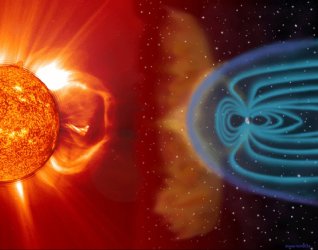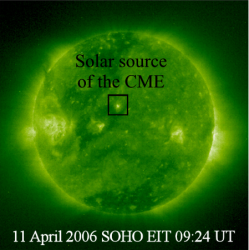
Artist's impression of a CME impacting the Earth. Courtesy: ESA
Science Nuggets: The Sun-Earth Connection
Locating the source of Earthward-bound CMEs
Important drivers of space weather are coronal mass ejections (CMEs); large-scale explosions on the Sun that eject plasma and magnetic field into interplanetary space. Sometimes these explosions are directed towards the Earth and change the conditions in space near the Earth in such a way that power cuts may occur at the Earth's surface and satellites may be damaged. At present, it is not easy to predict the arrival at Earth of those solar events associated with these catastrophic effects. By developing our understanding of the eruption and structure of CMEs, and their evolution as they propagate into interplanetary space, we will be better able to anticipate when these types of events may occur, allowing appropriate action to be taken to protect spacecraft. In order to do this, it is necessary to be able to correctly identify the source regions of these CME's.

Image of the Sun in EUV (195 \A) from SOHO EIT. Image adapted from Steed et al. (2008)
In a recent paper, Steed et al. (2008) compared in-situ observations of a CME from spacecraft close to the Earth with remote observations of the Sun to determine the source region of the CME. By considering the links between a number of pieces of evidence; including location, timing, and magnetic flux and helicity, they were able to trace the CME back to a very small active region on the Sun. Successfully identifying the source region of CMEs observed in-situ is the first step in understanding the magnetic topology of the structure and how and why the solar eruption occurred.
For more details, see:
Steed, K.; Owen, C. J.; Harra, L. K.; Green, L. M.; Dasso, S.; Walsh, A. P.; Démoulin, P.; van Driel-Gesztelyi, L.
Locating the solar source of 13 April 2006 magnetic cloud
Ann. Geophys., 26, 3159-3168 (2008), [Online]